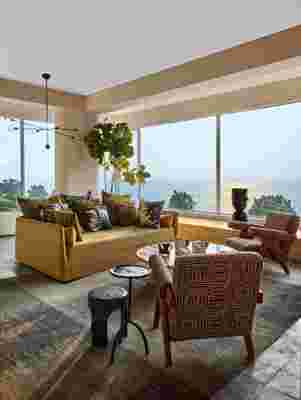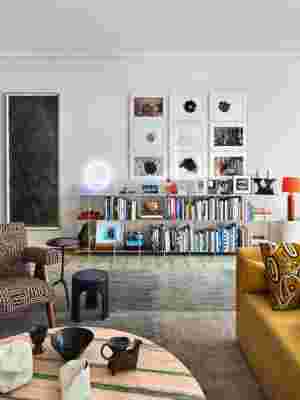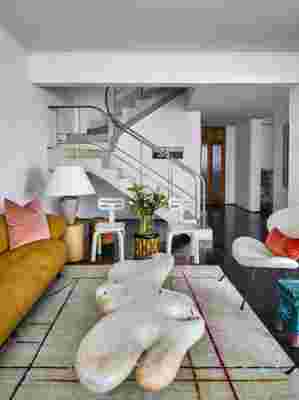Tour a Dreamy Mumbai Apartment with Waterfront Views
Of the many adjectives that come to mind when one walks into the sumptuously stylish Marine Drive apartment of Cecilia Morelli and Rohan Parikh—sweeping, striking, inviting, vibrant— khichdi is not one. Yet Cecilia references the desi dish, as well as the French slang word bordel (“chaos”) to describe her recently renovated home. The two-story, 5,000-square-foot residence unites global and local sensibilities in a stylish manner that’s unabashedly “glocal,” so to speak. The outcome: a sophisticated yet comfortable dwelling for the family—which includes the couple’s six-year-old, Gaia, and two dogs—that is both respectful of tradition but not entirely bound by it. It’s Paris meets Palm Springs meets Los Angeles meets Mumbai.
A co-founder of Le Mill , a decade-old multi-brand concept store for fashion and home decor, the 39-year-old half-French, half-Italian Cecilia fused her multicultural, multi-city upbringing with her adopted homeland’s architectural and artisanal aesthetic. Ten years after moving into her 1930s-era Art Deco home, she had the opportunity to combine her existing apartment with the one upstairs; an exciting prospect, since Cecilia likes nothing more than to design interiors. “I am a crazy person who falls asleep at night visualizing the space I am creating,” she says. “I put the objects in the space in my mind—I don’t need to see them physically—and I can place them. That’s how my brain works.”
The Parikhs knew they wanted to retain their apartment’s maritime heritage, and utilize local crafts and materials to underpin a strong architectural language. They also wanted their significant art collection to have pride of place. Samuel Barclay of Mumbai-based firm Case Design was the obvious choice to help realize their vision. “I wanted a house that was pure, and by that, I mean a purity in [terms of the] use of materials,” says Cecilia. “I knew that Case could bring the best out of a material, whether it’s wood or plaster or cast iron or cast bronze. They are people who really deeply respect the modernist heritage of Indian design that is often overlooked in new developments and new architecture.”
Barclay, who knew Cecilia both professionally and personally (Le Mill sells Case Design products) says that the project was a meeting of the minds. “It was trying to blend their aspirations for a home and our ideas about space and materiality.” He notes that, historically, Marine Drive apartments tended to be quite compartmentalized. The Parikhs wanted free-flowing rooms that opened to the view. Barclay, fellow architect Dhwani Mehta, and designer Paul Michelon —all from Case Design—joined the two flats via sculptural cast-in-place concrete and IPS (Indian Patent Stone), to create a formal living and dining area near a pantry-cum-kitchen, with a more relaxed family room and bedrooms upstairs. The downstairs also houses Rohan’s office and an en-suite guest room, while the upstairs includes Cecilia’s office space, Gaia’s delightful tree house playroom, an eat-in utility area, and Cecilia’s generous closet.
Taking inspiration from BV Doshi and Le Corbusier, as well as modern elements in Indian design, the floors are IPS-imbued with natural color pigments developed by Malene Bach , the Copenhagen-based visual artist, and crafted by Rameshwar Bhadhwa and his firm, Mortar Construction. Bach and Mehta toiled alongside Gujarati artists to devise just the right hues for the pale-green staircase, the deep red in the enclosed lower-level balcony, and custom-developed silicate paint for all the walls in the home. The family’s bathroom tiles are handmade and sourced from Moroccan artisans. The woodwork retains some of the original Burma teak from 1932 that can be found in the door frames. Michelon designed several pieces of bespoke furniture, including a stone console in front of a sea-facing window that took six months to produce. Case also designed every light switch, door handle, and keyhole, while working alongside Poonaram Suthar of Vishwakarma Furniture on the carpentry. The art—which reads like a laundry list of some of the most important contemporary artists in India and overseas, including Shilpa Gupta, Bharti Kher, Jitish Kallat, Sudarshan Shetty, Goutam Ghosh, Oscar Murillo, and Amitesh Shrivastava—acts as a perfect complement.
While Rohan dealt with the technical aspects of the renovation, Cecilia spent two years buying furniture—mostly online. She raided auction sites like Wright and Piasa. She also turned to stores around the world, including R & Company , The Future Perfect , Mint gallery in London, and Side Gallery in Barcelona. Cecilia commissioned a Sabine Marcelis bench for the entrance. Elsewhere, Christophe Delcourt sofas adorn the living room along with Lina Bo Bardi armchairs and original George Nakashima chairs sourced from his daughter. Dirk Vander Kooij’s recycled plastic Chubby chairs, a coffee table by Rogan Gregory, and a stool by Ashiesh Shah can also be seen. In almost every room, these high-design pieces are mixed in with Parisian flea market finds. And while the placement of each piece is tightly controlled, the overall feeling is one of warmth, thanks to use of color.
Summing up her design philosophy, Cecilia says, “When you are dressing you don’t necessarily wear the same materials—it’s the same idea. I wanted great pieces and was not discriminatory about which century they came from, or what material they were made of. It’s important to collect things as you see them.”

The hanging light on the left, by Apparatus, is available at Le Mill. The Totem vase on the right is from Atelier Ashiesh Shah. The block cast-iron stools are a series by Ravi Vazirani.

The family room features a pink-marble Cylinder table by Casegoods, a Chandigarh chair upholstered in a Pure Concept fabric by Phantom Hands, black cast-iron stools by Ravi Vazirani, and a basket-weave rug by Vikram Kapoor—all from Le Mill. The Ghost sofa by Paola Navone has been upholstered in a Pierre Frey fabric. The Halo light is by Sabine Marcelis; next to it is a set of nine drawings by Aditi Singh, titled Insomnia. The Hold Shelf is designed by Paul Michelon for Casegoods. The charcoal drawing on the left is by Aji VN. The painted orange lamp by Cathrine Raben Davidsen is from The Future Perfect.

The Rogan Gregory coffee table at the centre of the living area was bought at R & Company. The white Chubby chairs by Dirk Vander Kooij are from Mint, a London design gallery; the Channapatna stool between them is by Ashiesh Shah Atelier, from Le Mill. The salmon-pink Candy Column side table is by Sabine Marcelis; the ceramic David Whitehead–designed lamp is from Pelazzo Lexcellent Antiquités. The sofa is by Christophe Delcourt; the green terracotta stool is from Mint; the recycled sari-silk rug is by Danish artist Malene Bach for Le Mill.
A Bharti Kher sculpture sits at the entrance to the living room. The sofa is by Christophe Delcourt; the coffee table by TH Robsjohn-Gibbings was acquired from Wright Auctions. The Rope chair was designed by Adrien Audoux and Frida Minet; the green Tridente armchair is a Lina Bo Bardi design. The ceramic vases on the coffee table and Vikram Kapoor rug are from Le Mill. Above is a Stilnovo light from 1stDibs; in the corner is a standing light by Bec Brittain.
The photograph in the pantry is a 2008 artwork by Tejal Shah, titled Photophobic Hysteric.
The hanging light, by Apparatus, is available at Le Mill. The dining table is by Casegoods. The dining chairs—with leather backs and seats—are by BDDW. The artworks are by Jitish Kallat (right) and Neha Choksi. The blue shelf is by Odd Matter, from their Mass collection.
The marble Eros table by Angelo Mangiarotti in the living area was sourced from a Paris flea market. The two Conoid host chairs by George Nakashima were purchased directly from his daughter, Mira. The terracotta sculpture is by Kolkata-based artist Khageshwar Rout. The oil painting, titled Beach, is by UK-based artist Matthew Krishanu.
The artwork on the left is by Josh Tonsfeldt.
In the powder room a Dayanita Singh photograph is reflected in the mirror.
The primary bath is decorated with burnt-red ceramic tiles sourced from Morocco. The terrazzo bathtub and sink are by Case Design.
This tree house in the playroom is by Case Design.
Cecilia’s dressing room.
The dining room features a Shilpa Gupta artwork titled Someone Else .